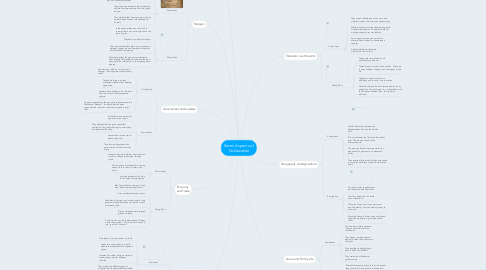
1. Religion
1.1. Summerians
1.1.1. They had gods to worship all the elements such as wind, sun, and sky.
1.1.2. The Mesopotamians had a polytheistic belief,they had hundreds of gods and worshipped them in many different ways
1.1.3. The people depended on the relationship with their own personal god for their good fortune.
1.1.4. They believed that demons were made by gods through humans with the heads of animals .
1.2. Shang Zhou
1.2.1. In the dynasty there was not much in common there was a strong belief in the same religion.
1.2.2. They had a polytheistic religion
1.2.3. They also believed that there was a connection between the people and heavenly beings that influenced their prosperity.
1.2.4. They thought that the god communicated to them through the peoples leaders and the god would give them instructions to help keep them pleased
2. Government and Leaders
2.1. Shang Zhou
2.1.1. This area was ruled by a monarchy in Anyang. The kings were surrounded by courts.
2.1.2. They had a large army that prevented rebellions and fighting opponents.
2.1.3. Leaders in the elie had a lot of leisure time to hunt and collect expensive objects.
2.1.4. To gain acceptance to the people the leaders used the Mandate of Heaven. This stated that the gods supported the ruler and would have anyone corrupt rule.
2.2. Summerians
2.2.1. As battles arose war chiefs began to rule as kings.
2.2.2. They believed that the gods controlled everything. The priests had high power status and governed the cities.
2.2.3. Leaders had ceremonies to please the gods.
2.2.4. They formed dynasties which were a series of rulers from one family.
3. Economy and Trade
3.1. Summerians
3.1.1. Lacked many raw materials, like wood and metal, so they obtained them through trade.
3.1.2. Traded across Southwest Asia, trading woven cloth for wood, metals, and stone
3.1.3. As trade developed, so did a social status among people.
3.1.4. Men had political power and made laws, while women stayed home.
3.2. Shang Zhou
3.2.1. Coins circulated through society.
3.2.2. Consisted of farmers, and metal workers. Here people worked with stones and metals such as bronze and jade.
3.2.3. Goods circulated more through gifts and tribute.
3.2.4. Each city was a noble fortress,based off kings and a caste system. Your were born into your job, you didn't choose it.
4. Science and Technology
4.1. Sumerians
4.1.1. Developed a number system up to 60.
4.1.2. Learned to use geometry, to build elaborate structures and an irrigation system.
4.1.3. Invented the wheel, which was used to make pottery, and for different vehicles.
4.1.4. They preformed different types of surgeries, and learned different medical advances.
4.2. Shang/ Zhou
4.2.1. They used picture symbols to represent ideas and objects.
4.2.2. They successfully used and worked with bronze.
4.2.3. They were able to build huge structures such as tombs
4.2.4. Created a precise calendar based on the cycles of the moon.
5. Brenden Rauch, Heather L'sperance, Isabella Moskowitz
6. Social and Family Life
6.1. Summerians
6.1.1. The Families in Mesopotamia loved to eat food and have celebration.
6.1.2. They began to urbanize annd began to make their cities more complex
6.1.3. They had the worlds first cities back in 4000 and 3500 B.C
6.1.4. They were part of the hunter gather society
6.2. Shang/ Zhou
6.2.1. Bronze first became known in this time period they used this for things such as rituals and drinkin vessels
6.2.2. This metal was a symbol of royalty and describes the social class you belong to
6.2.3. They were never a wholly unified realm they started to favor the more wealthy families.
7. Geography and Agriculture
7.1. Summerians
7.1.1. Fertile Cresent was between the Mediterranean Sea and the Pursian Gulf.
7.1.2. Rich soil between the Tigris and Euphrates river. This are was known as the Mesoptomania.
7.1.3. The area was flat and swampy which was well suited for grains such as wheat and barley.
7.1.4. They received little rainfall so they dug canals to store the water that carried down into the fields.
7.2. Shang Zhou
7.2.1. Two major water supplies were the Yangzi and Huang He river.
7.2.2. The rivers deposited rich fertile soil on the plains.
7.2.3. Along the Yangzi river it was warm and received plenty of rainfall, making it easy to grow rice.
7.2.4. Along the Huang He river it was cooler and drier, making it easy to grow wheat and millet.
8. Education and the Arts
8.1. Summerians
8.1.1. They carved little figures out of ivory, and sculpted statues with big, wide opened eyes.
8.1.2. Made their famous stone cylinders, engraved with detailed designs. They used these for writing and seals over clay tablets.
8.1.3. Some upper-class women earned an education and worked as priestesses in temples.
8.1.4. Created detailed architceture, with columns and arches.
8.2. Shang Zhou
8.2.1. The people carved jade for art and religious purposes.
8.2.2. Carved bronze vessels, called taoties. They were in many different shapes, such as dragons, birds, ect.
8.2.3. Learned to make bronze more efficiently, and to carve it more precise.
8.2.4. The skills that you learned were passed down by generation. You never went to a school where you could choose different jobs. Your job was inherited.
